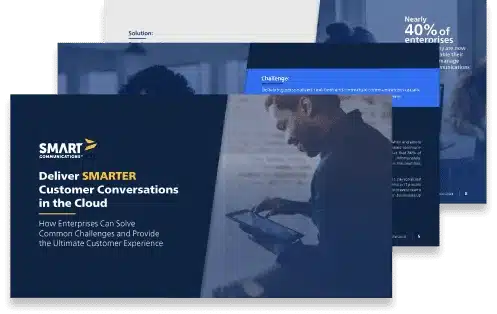Fixing First Impressions: How Automating Data Collection Can Fix These 5 Client Service Bottlenecks in Wealth Management

By Cindy Griffin, Vertical Marketing Specialist at Smart Communications
At our INNOVATE conference in New Orleans, keynote speaker James Dodkins (aka the CX Rockstar) delivered a powerful message:
“Many first impressions are out of your hands, but they are never out of your control.”
In wealth management, first impressions matter deeply. Whether it’s a prospective client onboarding for the first time or an existing one updating their information because of a life change, the experience they have with your firm shapes how they perceive you.
And yet, many wealth management firms are unintentionally making the wrong impression. Outdated, manual client service processes are creating friction, delays, and frustration; these are the bottlenecks that you must address. Simply stated, these bottlenecks are creating the wrong impression. In this article, I’ll dive into how automating data collection processes can help wealth management organizations overcome these challenges.
Legacy Processes Are a Challenge to Scale
As demand for personalized service grows and advisor-client interactions become more complex, wealth management firms are under pressure to deliver a high-touch experience at scale. But for many firms, the reality looks more like this:
- Endless back-and-forth emails for missing documents
- Paper forms and wet signatures
- Tedious manual rekeying of data into multiple systems
In 2025, the most common client service bottlenecks can be traced to one root issue: outdated data collection processes. Modernizing how your firm collects and conveys data can eliminate friction, unlock scalable workflow automation, and, most importantly, create great impressions on your clients.
Here are the five most common bottlenecks and how you can solve them:
Bottleneck #1: Manually Collecting Data from Clients
Advisors and client service staff often waste hours tracking down forms, missing data, or signatures from clients. These requests are typically handled by email or phone, creating fragmented communication trails and introducing significant room for error.
The Result: Slow onboarding, frustrated clients, and inefficient use of staff time.
The Fix: Replace manual methods with guided, digital experiences that accurately collect data the first time. Intelligent, online, mobile-friendly forms validate inputs, ensure completeness, and eliminate the back-and-forth.
The Smart Approach: Firms using forms automation solution SmartIQ have reduced data collection time by 60% to 75%. And Not In Good Order rates? Organizations leveraging SmartIQ have reduced them from a typical industry standard of 35% to 2%. In short, SmartIQ’s no-code/low-code solution transforms traditional form-based processes into fast, secure, fully automated digital experiences that make it easier for clients to engage and firms to scale.
Bottleneck #2: Fragmented Data Handoffs Between Teams
Even when client data is successfully collected, it often gets stuck in operational limbo or becomes siloed. Staff members email spreadsheets, print forms, or manually re-key information into internal systems, creating bottlenecks and a risk of data loss, incorrect data, or duplication.
The Result: Disjointed workflows and costly handoffs that delay client service.
The Fix: Workflow automation tied to automated data collection allows client information to move seamlessly between people and systems. This eliminates double-handling (unnecessary rehandling of materials or information) or siloed information and creates a single source of truth.
The Smart Approach: SmartIQ eliminates fragmented data handoffs by capturing structured, validated data at the point of entry and routing it through integrated workflows. Instead of relying on emails, spreadsheets, or re-keying, SmartIQ connects with CRMs, portfolio accounting, and other internal systems via prebuilt connectors and flexible APIs. This ensures accurate client data flows seamlessly between systems, reducing manual effort, cutting processing times, and creating a “single source of truth” for every interaction.
Bottleneck #3: Compliance Delays Due to Incomplete Data
A missing checkbox or signature can kick off compliance alerts that start a cascade of manual reviews, rerouting, and rework. These delays aren’t just operational headaches. A recent Capgemini report cited a survey showing a 31% increase in penalties on global financial institutions for anti-money laundering and know your customer violations. Non-compliance can significantly impact profits and regulator relationships.
The Result: Delays that not only make a bad impression on clients, but also increase regulatory risk.
The Fix: Automated digital data collection solutions can prevent errors by collecting the information at the source. Intelligent forms ensure all required fields are completed and compliant before submission.
The Smart Approach: SmartIQ reduces compliance delays by ensuring that data is complete, accurate, and validated before submission. Guided digital interviews dynamically adjust based on client responses, so required fields are never missed. Built-in logic checks and field-level validation reduce the risk of human error, while version control ensures the most current regulatory templates are always used.
Bottleneck #4: Lack of Real-Time Visibility into Client Progress
Too often, advisors and client service teams don’t know where a client is in a process. Has the form been started? Submitted? Is something missing? This lack of visibility leads to redundant follow-ups, delayed services, and poor client experiences. According to an Avaloq wealth management survey, 30% of ultra-high-net-worth (UHNW) clients experience onboarding times of three months or more. This is a level of delay that can damage trust and hinder long-term relationship growth.
The Result: Advisors are operating in the dark, and clients can see it, hurting critical retention efforts.
The Fix: Automated systems with a clear view of where each client’s request stands can give teams the visibility needed to support clients more effectively. When everyone has insight into a client’s status, it’s easier to anticipate needs, reduce delays, and provide a more seamless experience.
The Smart Approach: With SmartIQ’s real-time dashboards and progress tracking, teams gain full visibility into where clients are in the journey, enabling proactive support. Built-in audit trails and status updates provide transparency, so nothing falls through the cracks.
Bottleneck #5: Diminishing ROI from Manual Processes
Peak times like tax season or year-end planning place tremendous strain on advisors and client service teams. Advisors and client service teams are stretched or delay non-urgent work. Firms cannot simply add headcount to address this problem.
The Result: Advisors and client service staff are burned out and miss opportunities to deliver high-value client service. Manual work scales costs, not service quality.
The Fix: Automating data collection and related workflows frees up staff for higher-value tasks, like client outreach and strategy. It’s the only sustainable way to scale without increasing headcount.
The Smart Approach: By turning manual workflows into intelligent, digital experiences, SmartIQ dramatically reduces time spent during peak periods on repetitive tasks like data entry, document review, and chasing missing information. This leads to higher operational efficiency, lower costs, and more time for advisors and staff to focus on delivering value to your clients.
The Path Forward for Client Service Teams
Digital transformation isn’t just about modernizing infrastructure. It’s about creating client service operations that are fast, efficient, and, most importantly, leave a great impression.
Automation allows firms to move faster, reduce manual errors, and give clients the seamless experience they expect. And it frees advisors to focus on what matters: building great relationships.
Forward-thinking firms are already reimagining their service model with automation. If your firm is still reliant on PDFs, emails, and manual follow-ups, now is the time to explore how SmartIQ can fit into your roadmap.
Because that first impression? It’s not out of your control, it’s just waiting to be automated.
For more information on how these challenges impact customer experience, and how your organization can overcome them, access a complimentary copy of our 2025 Benchmark report. Be sure to watch the video below for insights from the report.
About the Author
Cindy Griffin is the Financial Services Vertical Marketing Specialist at Smart Communications. She has more than 25 years of experience in financial services marketing and business development, performance analysis, product and risk management, and compliance integration. Cindy has broad knowledge of the financial services space having worked for institutional investment managers, retirement services providers, and wealth managers in a variety of roles. In addition, Cindy worked in business development for a software provider with a primary focus on the financial services vertical.



